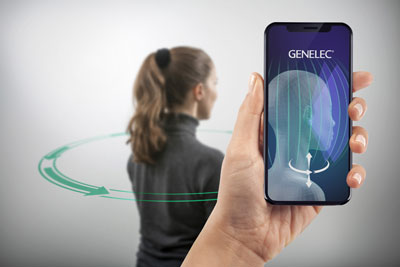Genelec announces a significant first step in improving the trustworthiness of headphone listening through the introduction of its new Aural ID software technology. Aural ID works by acquiring a person’s exclusive acoustic attributes to create a detailed modeling of their unique anatomical features affecting hearing, which can then be compensated for – thus enabling the delivery of more truthful and reliable sound when headphones are employed for reproduction.
 Recognizing that traditional “one-size-fits-all” headphone reproduction fails to yield a proper reliable reference for audio professionals, Aural ID calculates the user’s personal Head Related Transfer Function (HRTF), which describes the acoustical properties of the head, upper torso and external ear: elements that interact in complex ways to affect sounds reaching the eardrums. Aural ID then computes all these elements and creates a personal data file characterizing the modification to sound arriving from any azimuth and elevation. This file consequently enables an audio engine to precisely render stereo or immersive content via headphones.
Recognizing that traditional “one-size-fits-all” headphone reproduction fails to yield a proper reliable reference for audio professionals, Aural ID calculates the user’s personal Head Related Transfer Function (HRTF), which describes the acoustical properties of the head, upper torso and external ear: elements that interact in complex ways to affect sounds reaching the eardrums. Aural ID then computes all these elements and creates a personal data file characterizing the modification to sound arriving from any azimuth and elevation. This file consequently enables an audio engine to precisely render stereo or immersive content via headphones.
Until now, gathering personal HRTF information has been a complex and time-consuming process that requires an anechoic room, placement of measurement microphones at the entry to the user’s ear canals, and careful attention to setup and procedure details with multiple measurements. Yet even after these steps have been taken, the data gathered is less comprehensive than that attainable using Aural ID, and can still be prone to errors.
By contrast, Genelec Aural ID software simply requires the user to provide a 360-degree video of their head and shoulder region – for which a high-quality mobile phone camera is sufficient. Once the video is uploaded to the Genelec web-based calculation service, the calculation process first builds an accurate and detailed 3D model scaled to exactly the correct dimensions of the head and upper torso, with special attention paid to modeling of the external ears. After this, acoustic fields are analyzed and calculated numerically with a full-wave method to capture detailed acoustic phenomena. The acoustic fields are computed for hundreds of different orientations of audio approaching the head, after which the HRTFs are formed and the data is finally compiled into a downloadable SOFA file – a format that has been defined and standardized by the Audio Engineering Society (AES). This maximizes the technical compatibility of the HRTF data file, since the SOFA format is already supported by many virtual reality (VR) and game audio rendering engines.
Indeed, Genelec see those working in academic research, immersive audio monitoring, VR and games development as likely early adopters of the new Aural ID technology.
Genelec Managing Director Siamak Naghian comments, “In the same way that our monitor loudspeakers established the sonic reference for professional audio monitoring, and GLM calibration software revolutionized the way studio monitors could be optimized for any acoustic space, we are determined to help bring standards of sonic truthfulness to headphone reproduction. With an increasing number of audio professionals relying on both in-room monitors and headphones, Genelec Aural ID is a significant first step towards the use of headphones for actual reference audio monitoring and listening.”
The Genelec Aural ID service will become available for purchase online via the Genelec Community website during Q2 of this year.
For more information, visit www.genelec.com.

